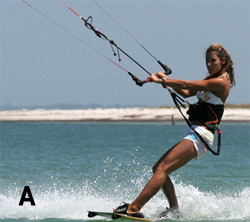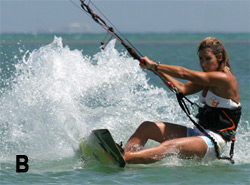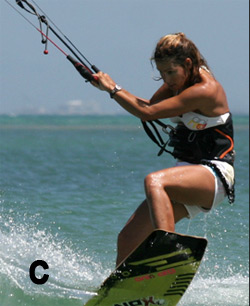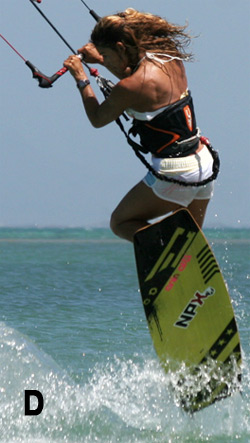Popped Front Loop
It’s always good when you have the chance to learn something that looks exquisite; the hooked in Popped Front Loop is such a cherub. Even when it is too windy to show off all the technical tricks in your armory, this adds up with a cheeky Indy Grab that will keep most of the pop fanatics happy. It is a great way to get your head around an unhooked popped front and it is a welcome alternative to a sent jump front. It will work on the flat off a wave and because you can control the power in the kite, even the chop won’t stop you.
The essence of any pop trick is that all your upward force comes from you alone, with no help from the kite. However the position of your kite will affect how much height you get. The nearer it is to 12 o’ clock the more lift you will have. So it stands to a reason that if you are learning this move, you should have the kite around 11 o’clock. This way the kite will be just low enough that you can edge against, but it will also be high enough to give you some bonus lift and assist with getting your board back under you.
IMPORTANT STAGES
The Approach
 As you won’t be using the kite for the lift, you will need some quickness and speed so you can pop hard. Assuming that you popped, you will already know that generating your speed can be increased by heading slightly off the wind with the power of your kite. Just try and change your direction smoothly by steering the board in front rather than standing up on it.
As you won’t be using the kite for the lift, you will need some quickness and speed so you can pop hard. Assuming that you popped, you will already know that generating your speed can be increased by heading slightly off the wind with the power of your kite. Just try and change your direction smoothly by steering the board in front rather than standing up on it.
Pic A – Shows that the surfer is in a perfect pre-pop position. The kite is on 11 o’clock direction and has steered the surfer’s board off the wind by the feet’s extension. To maintain a good stance, you need to push your front leg out and move your hips back behind your back foot. Your shoulders should be still behind your hips and the board is still in between you and the kite. Keep your hands on the center of the bar to prevent any unwanted kite movement. Here you can acquire speed that will give you an attempt to carve back onto your edge.
The Carve
 This isn’t the moment to consider on as in reality it only lasts a split second. However your body position here is the important thing because it defines the amount of pop that you will get. Visualizing it first and foremost can be of benefit.
This isn’t the moment to consider on as in reality it only lasts a split second. However your body position here is the important thing because it defines the amount of pop that you will get. Visualizing it first and foremost can be of benefit.
Pic B – Best Place to start is the surfer’s kite face. To get a decent pop and enough rotation, you need a bit of an effort and aggression to go up. Next see how close the surfer has his derriere to the sea. This is only possible because of the position taken into the pop. With the surfer’s weight back and upwind, it is easy enough to get back on the edge by turning suddenly on upwind. Using your shoulders to twist your body around your hips for the board turn can give you a quick flexibility for the move. See that the back leg of the surfer is flexed and ready to extend, and the front leg extension keeps the surfer’s board on edge. As soon as you get into the position, you must be ready to pop up or else you will lose speed. Final point here is not to pull on the back hand.
The Take Off
 As you know from a front loop, the take-off is everything as it initiates the rotation. It also needs to give you pop so the trick is to fire yourself into the rotation without flattening the board off.
As you know from a front loop, the take-off is everything as it initiates the rotation. It also needs to give you pop so the trick is to fire yourself into the rotation without flattening the board off.
Pic C – shows that the surfer explodes for the take-off. You can see how the back leg extends against the resistance of the edge of the board, thus pushing the body up. However unlike a sent front loop, it doesn’t throw across the board towards the sea on the other side, as this would flatten the board. Instead the surfer throws his head towards the nose of the board allowing a bend sideways at the waist. This stage is enough to start the rotation. Faith is the key.
 Pic D – Clearly demonstrates the commitment to the pop. As the surfer goes up, bar-in is the one you should keep in mind because if you do so, rotation can be easy in middle lines. See the surfer’s front hand as his steering connection slows down the kite to make sure it doesn’t drift up. The surfer is now in a textbook position to throw the rotation. With your back leg extended and front leg bent combined with your weight down, your next step is to forward now to speed up your rotation and turn your head to look back over your trailing shoulder and bend your back leg.
Pic D – Clearly demonstrates the commitment to the pop. As the surfer goes up, bar-in is the one you should keep in mind because if you do so, rotation can be easy in middle lines. See the surfer’s front hand as his steering connection slows down the kite to make sure it doesn’t drift up. The surfer is now in a textbook position to throw the rotation. With your back leg extended and front leg bent combined with your weight down, your next step is to forward now to speed up your rotation and turn your head to look back over your trailing shoulder and bend your back leg.
Pointers to Consider
It is highly recommended practicing kiting across the wind with a speed before bearing away and then turning up again to concentrate on your body position. Once you have done this a few times, just add the pop off the back leg and you will find that popping hard with your front shoulder is actually easy. If you lose balance, most likely you are not bearing away enough before carving hard. The more downwind you start the less far you have to rotate.
The Trick in Sequence
1-2. Notice the surfer keeps the bar in close, keeps the kite steered forward and throws his head and shoulders down towards the nose of the board. Now that the board is clearly off the water, the surfer needs to rotate faster.
3. The surfer quickly turns the head to look back over his rear shoulder.
4-5. As long as the surfer keeps the bar the kite steered forward while he keeps looking over the shoulder, the rotating will continue to go.
6. Once the surfer can see the water, the concentration will be on where to land.
7-8. As the surfer’s leg comes around, the extension of the legs should be ready for landing. Aiming to land the tail first, pointing downwind on a flat board and not on the edge the surfer carries a fair amount of speed. As long as the tail lands first, the board can pivot further around and downwind.
9. The surfer lands, absorbs the impact and keeps head up looking where to go with balance in hand. The surfer has the bar in and the kite steered forward always.
Key Marks
1. Speed, off the wind
2. Weight back over tail off board
3. Carve hard, pop up and forward
4. Steer the kite down
5. Flick! Good job!
Here´s what it will look like!

Leave a Reply